Wastewater treatment history is somehow a history of mankind. For centuries and millennia, sewers have told much more about our societies than any other city part. This was true in the Mesopotamian Empire (3500-2500 BC), when the first sewers were built, and is still true today, where sewers probably are the best way to track the evolution of a pandemic. In between, there have been times where wastewater wasn’t collected. And until recently, it was not treated at all! So, about how long have wastewater treatment plants been in existence?
This is part of our deep dive on Water and Wastewater Treatment
Table of contents
Wastewater Treatment History is much shorter than the Drinking Water one
When Homo Sapiens turned into Cavemen, he soon realized, that he needed access to good quality drinking water. This is why he was establishing his homes near sources, rivers, and lakes. But when it came to disposing of his droppings, some holes in the ground used to “do the trick”.
How should we blame him? The importance of proper sanitation wouldn’t be discovered before the 19th century!
The thing is, humankind had to learn the hard way, how important wastewater treatment is. For centuries, wastewater was disposed of in the streets and close to high population densities. This had obviously serious impacts on public health, along with the environment.
But while numerous epidemics have ravaged Europe through the Middle Age and until the 19th century, humans still tended to have short memories, and easily forgotten that inappropriate sanitation wasn’t helping – at all.
Sadly enough, a terrible statistic summarizes this fact. Every 20 seconds, a child dies somewhere in the world from a lack of sanitation.
Indeed, the history of wastewater treatment only tends to evolve when three key parameters are aligned: suited technologies, political will, and desire for social reforms.
But before checking how treatments appeared, let’s review how wastewater first got managed.
A (short) History of Sewage
The first evidence of Drainage Systems has been found in Babylonia and Ur. Remains of homes from the Mesopotamian Empire (3500-2500 BC) show connections to a drainage system.
Even more interesting, some of these latrines were connected to cesspits. Considering that those Cesspits were the first iterations of the “modern” septic tanks, it can be considered as a wastewater treatment. Even if, of course, rudimentary.
So, that’s the first answer to our question! About how long have wastewater treatment plants been in existence? Well, about as long as we can track records of civilization, so 3500 BC.

Having started this early, one could expect wastewater treatment to be a science deeply entrenched in our civilizations. So how can it be, that still, 80% of the world’s wastewater remains untreated, 5500 years later?
The answer is terribly simple: sewage management and wastewater treatment is almost a reverse history of progress.
Infographic: Early Rise of Sewage Management…
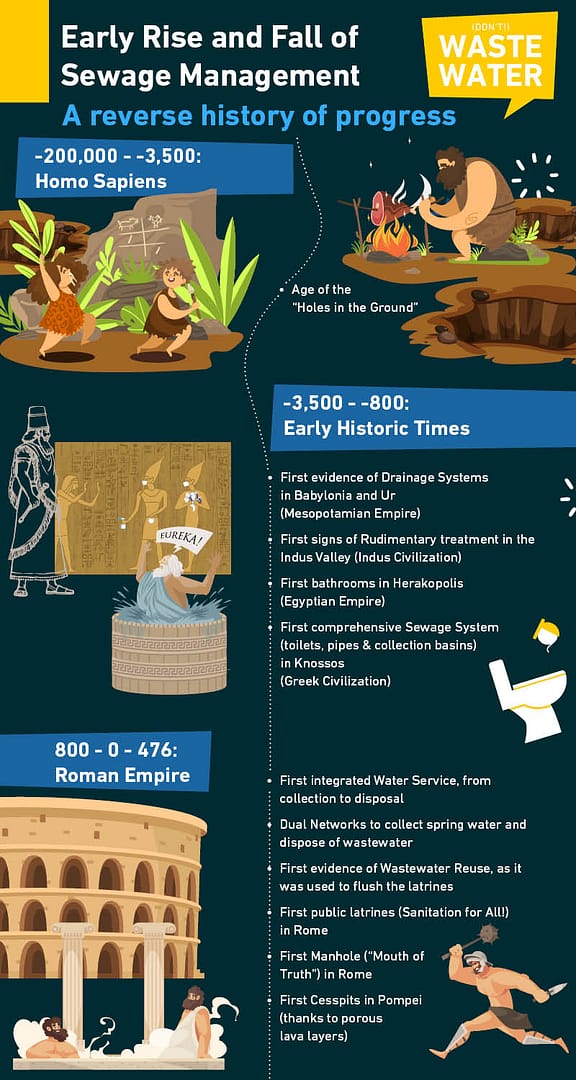
Early Historic Times (-3500 to -800)
The Mesopotamian Empire actually wasn’t an exception in antiquity. The Indus civilization was also very advanced in sewage management, with a high priority given to hygiene. The dense settlement in cities like Harappa and Mohenjo-Daro pushed municipalities to care closely about sewage. Houses were connected to drainage channels and sumps were used to catch the heavier solids.
Drainage channels were covered with bricks and stones so that maintenance works could be carried out. All of this, as early as 2’500 BC!
Some centuries later, the finest houses in Herakopolis had bathrooms and toilets. This shows that ancient Egyptians cared as well about wastewater management, and this, since 2’100 BC. A bit less advanced than the Indus though, Egyptians would let wastewater flow directly to the desert.
But the most impressive of all ancient civilizations is probably ancient Greece, and particularly the city of Knossos. Built in 2’000 BC, the closed sewer of the city not only still exists, but is also still fully functional today! Kind of a definition of building to last.
The greeks had complete sewage systems. It started from collecting wastewater in the households, then conveying it in sewers to collection tanks outside the cities. This black water was then used as irrigation to fertilize crops in fields nearby.
Roman Empire (-800 to 476)
The Romans didn’t invent sewage management but improved it to a level of excellence that could make modern civilizations blush.
Actually, they were the first to build an integrated water service, from collection to disposal. Romans soon realized, that spring water was much better for human health than surface water, which led them to build the aqueduct infrastructure we can still see nowadays.
They also valued water as a precious resource. This led them to recycle wastewater from the spas and reuse it to flush the latrines. Closing the water cycle in a manner that we still struggle to match!
This effort did not stop at the door of the richest homes. Rome also worked to supply public baths, water fountains, and latrines to everyone. This was sanitation for all, and a wider proportion of Romans had access to clean water and managed sewage, than Italians had, 2’000 years later.
In some places, local conditions were leveraged to bring wastewater treatment to new levels. This was the case in Pompei, where lava layers added a filtration touch to cesspits, effectively cleaning wastewater before returning it to the environment.
Infographic: … Fall of Wastewater Management
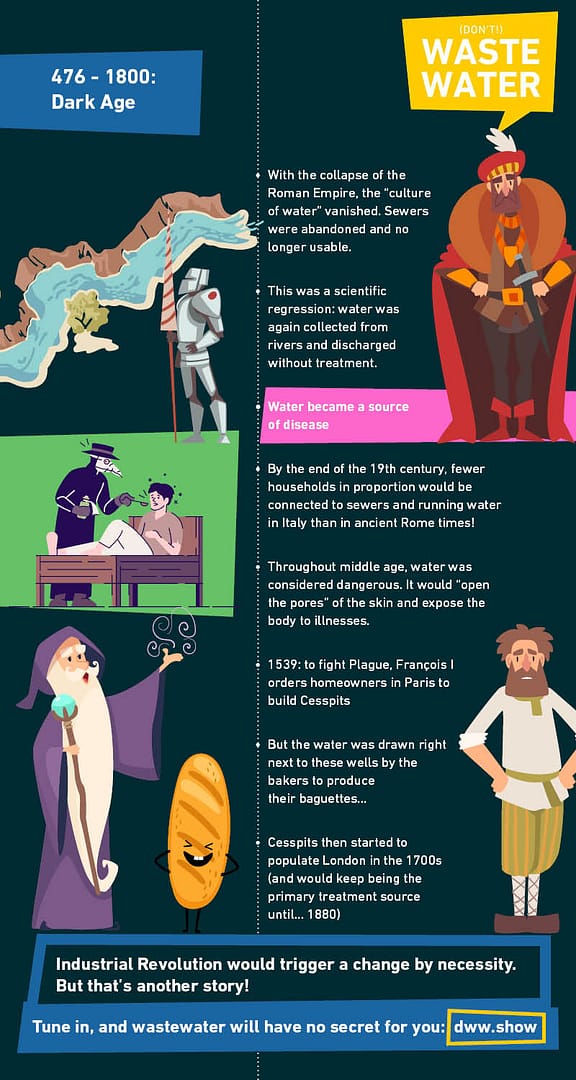
Dark Age (476 to 1800)
With the collapse of the Roman Empire, the “culture of water” vanished. If wastewater treatment plants somehow had been in existence since the Mesopotamian cesspits, it would simply disappear for more than a millennium!
Sewers were abandoned, and without maintenance they soon became unusable.
The same happened to the water infrastructure. Everybody forgot the science of the Romans, and water was again drawn from surface waters, regardless of direct pollution from all kinds of wastes.
Water became a source of disease and was even considered as directly harmful. It was said to open your skin pores, letting impurities in. So even bathing was discouraged.
A few exceptions to this overall regression included cities like Milan or Florence, where the use of Cesspits was still enforced, and a municipal service in place to empty them (and discharge them to the rivers).
Water spreading diseases
Plague epidemics ravaged Europe throughout the Middle Age and Renaissance, and this widely because of the lack of sanitation.
Even when positive measures were taken, such as François the First ordering homeowners in Paris to build cesspits, it was counterproductive. Indeed those leaking cesspits were located directly next to the 25-30’000 wells used in Paris at the time, to draw “potable” water.
This was a funny – yet unintentional – attempt at direct potable reuse, all of this with very rudimentary wastewater treatment.
Even in countries seen today as very progressive, such as Switzerland, wastewater management encountered heavy resistance. Farmers of Zürich almost rioted when the city planned to introduce sewers, as they used the wastewater for irrigation. And citizens of Basel voted against installing sewer and drainage systems many times, the last one in… 1881.
The early age of Wastewater Treatment
The industrial revolution spawned a major turning point. With always more people living in cities, the population concentration triggered a change in urbanization policies. Wastewater management could not stay an afterthought, and environmental conditions had to improve.
Infographic: The rise of Sanitary Enlightment
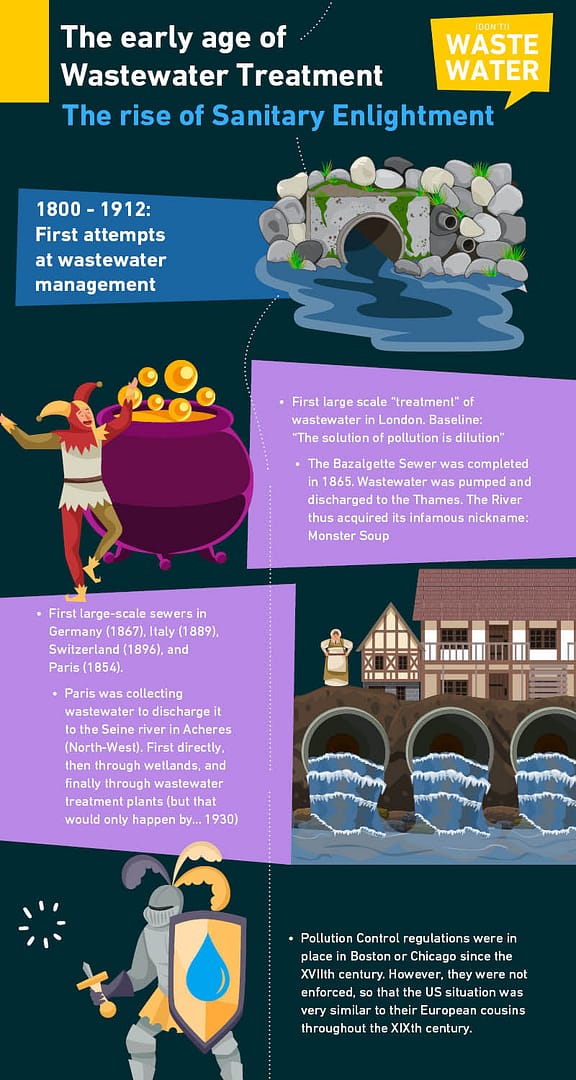
First attempts at wastewater management (1800 – 1912)
In a first attempt at solving the wastewater challenge, the city of London introduced a new philosophy. “The solution of pollution is dilution”.
Wastewater was collected across the city, with a sewer system being built from 1858 to 1862. It was then mixed with the Thames, without any considerations of assimilation capacity of the river.
Cesspools, that had been used in London throughout the 18th century were closed and replaced by flushing toilets. And all that flushed black water was rejected to the Thames, which rapidly became incredibly polluted. The river was given the nickname of “monster soup”.
Around this mid 19th century, several cities across Europe and North-America started building centralized large-scale sewers. Frankfurt was the first in Germany in 1867, Paris the first in France in 1854, Napoli followed in Italy in 1889 and Basel finally accepted to collect its sewage in 1899.
A slow transition towards treatment
Paris actually did not stop at collecting that wastewater. They also conveyed it outside the city, in the north-west, in Asnières then Achères. There, in a similar fashion to ancient greeks 4 Millennia earlier, wastewater was dispersed in specially reserved fields.
This was a good solution for Paris, as the Seine river was anyways flowing to the North-West, and thus taking pollution away from the heart of the city. But it was a disaster for Rouen, the next large city downstream on that same river.
This solution would nevertheless stay in place as is for another 40 years, before the construction of the Acheres, Valenton, Noisy-le-Grand, and Colombes Wastewater Treatment Plants.
On the other side of the Atlantic, pollution control regulations were in place in Boston or Chicago since the 18th century. However, they were not enforced, so that the US situation was very similar to their European cousins throughout the 19th century.
Infographic: The Early Age of Wastewater Treatment
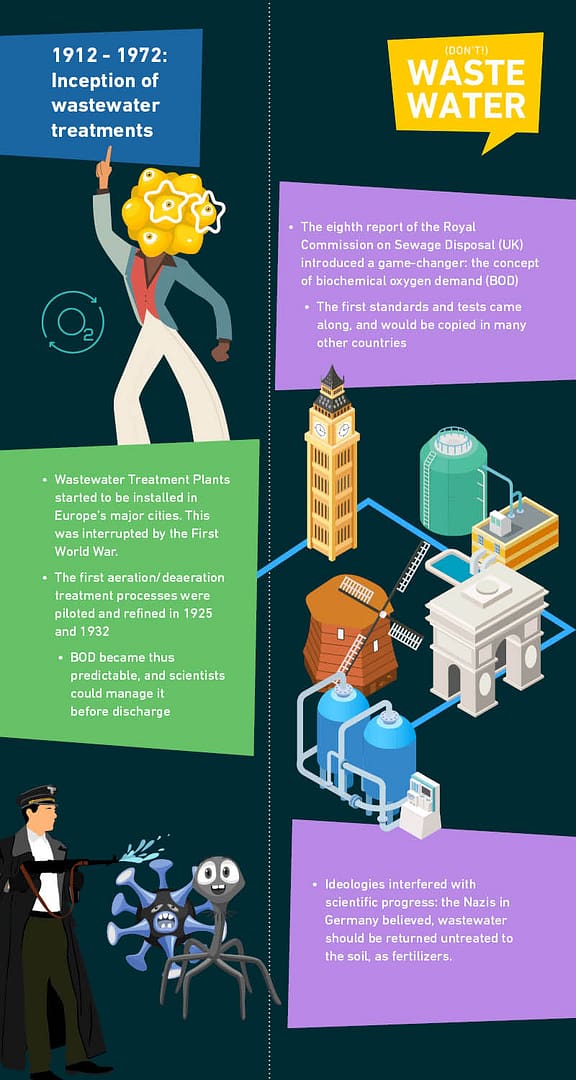
Inception of wastewater treatments (1912 – 1972)
Let’s raise one more time the question. About how long have wastewater treatment plants been in existence? Well, if we now speak of real wastewater treatment, and not just physical separation, the turning point is 1912.
What happened that year, is a revolution. For the first time ever, the Royal Commission on Sewage Disposal introduced a revolutionary concept: Biological Oxygen Demand (BOD).
Setting the mark, was first a way to measure the impact of wastewater discharge on the environment. But also a way to measure treatment efficiency, and set the regulatory threshold to enforce proper sanitation.
This breakthrough rapidly populated the other western countries. The deployment of wastewater treatment plants was then slowed down by the First World War but resumed shortly after.
The works of Streeter and Phelps (1925) and Imhoff and Mahr (1932) set the foundation stone for aeration/deaeration models that would remain as a cornerstone of modern wastewater treatment.
Ideological Limits and 2nd World War
Wastewater Treatment is of course a science. But it also has to cope with ideology. For instance, one of the key consequence of the early nazi-government in Germany, was to stop the wastewater treatment initiatives. Their “Blood and Soil” ideology was pushing towards fertilization of crops through sewage effluents, despite the newest advances in Sanitation and Science.
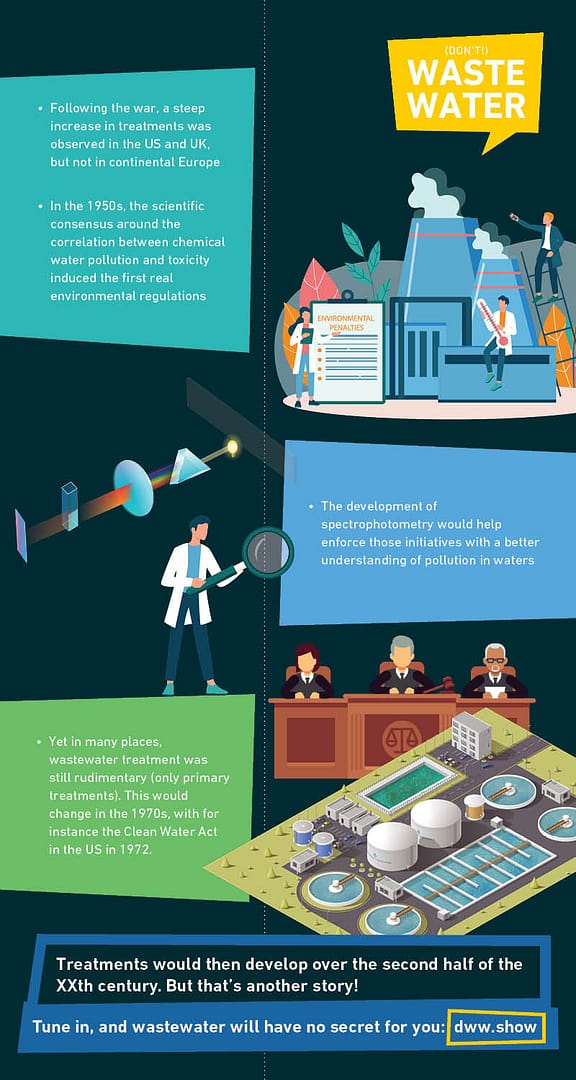
Another showstopper was of course the 2nd World War. Plant building was paused, and many existing facilities were damaged or destroyed.
If the sanitation effort resumed in some countries like the US or the UK straight after the end of the war, it would take longer in continental Europe. Priority was given to rebuilding the cities and economy, a bit less on preserving the environment and the human health.
Nevertheless, the scientific consensus around the correlation between chemical water pollution and toxicity induced the first real environmental regulations in the 1950s.
This would allow for Wastewater Treatments to develop over the second half of the 20th century. But that’s another story!
Conclusion: How Long have Wastewater Treatment Plants been in Existence?
Well, wastewater treatment has been around since the Mesopotamian Empire (3’500 BC), through the use of cesspits. Now, can we consider this a plant? Not really. Thus, the first wastewater treatment plants rather date back to the inception of BOD as a measurement, so from the beginning of the XXth century (1912).


